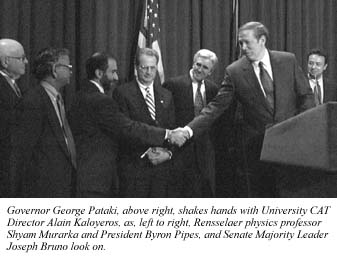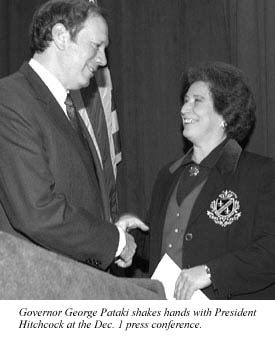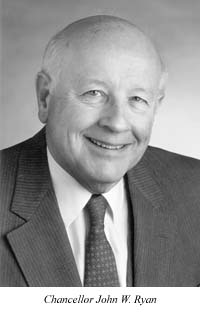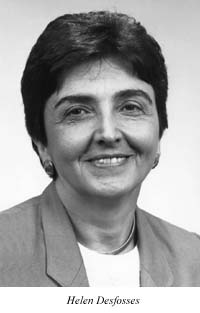University High-Tech Initiatives
Receive State Backing of $30-35 Million

By Joel Blumenthal
The key word was “partnership” on Monday when Governor George E. Pataki announced at a Capitol news conference that the State of New York will provide up to $35 million in support for two University high-technology initiatives that will spur future job growth in the Capital Region.
Senate Majority Leader Joseph Bruno, representatives of Assembly Speaker Sheldon Silver, President Hitchcock, Rensselaer Polytechnic Institute President R. Byron Pipes, SUNY Chancellor John Ryan, Board of Trustees Chairman Thomas Egan, Vice-Chairman Erland Kailbourne, and leaders of the Capital Region business community all were present at the announcement.
Pataki announced a partnership whereby the State will provide $5 million a year for five years to fund a joint University/Rensselaer bid to attract a major Semiconductor Industry Association (SIA) Focus Research Center, to be located at the University’s Center for Environmental Sciences and Technology Management (CESTM).
In addition, Pataki said, the State also will provide $10 million for the University to expand CESTM and create up to 100 high-tech jobs, by building a new wing that will house a pilot semiconductor manufacturing and workforce training facility.
“Around the world, the computer industry has taken note of the success of Silicon Alley in New York City,” Pataki said. “Now they will take notice that the Hudson Valley and Capital Region can compete with Silicon Valley and Austin, Texas, for the high tech jobs of the future. The $30- to $35-million State investment could attract $175 million in private industry investment.”
The Focus Research Center would be operated jointly by Rensselaer and Albany, in partnership with Stanford University and the Massachusetts Institute of Technology. It would be a principal research and development site for the SIA, which includes the major manufacturers of semiconductors and related products, in the area of interconnects, an essential component of computer chip technology.
The $5 million annual State grant will position Rensselaer’s Center for Advanced Interconnect Science and Technology, directed by professor Shyam P. Murarka, and the University’s Center for Advanced Thin Film Technology (CAT), directed by physics professor Alain E. Kaloyeros, to obtain the SIA Center.
The $10 million State grant is a result of the applied research conducted at the CAT, which, since its inception in 1993, has generated more than $35 million in funding and equipment, resulted in nine inventions and yielded approximately two dozen high-technology products. The Pilot Manufacturing/Workforce Training facility is intended to complement both the Focus Research Center and IBM’s new 300-millimeter semiconductor development plant.
Noting that total outside investment resulting from the research could
reach $2 billion, Senator Bruno said the initiative was “one of the most
important announcements the Governor could be making. When the Capital
Region prospers, all of New York State prospers.”

“This is a wonderful example of partnerships,” said President Hitchcock, noting the bi-partisan support for the two institutions’ efforts “to leverage the outstanding research being conducted by our faculty and students into commercial applications, which will result in economic growth.” After thanking Chancellor Ryan and the SUNY Trustees, she said to President Pipes, “Byron, I look forward very much to working with you.”
Pipes replied, “This will bring national recognition to our region in the vital area of microelectronics. Our research strengths are complementary,” he said, looking at Hitchcock. “It is our cooperation that will endure.”
Representing Speaker Silver were Assembly members Ronald Canestrari of Cohoes, who said the region will become an “economic powerhouse” in the semiconductor industry, and Jack McEneny of Albany, who noted that the Rensselaer-Albany partnership shows the strengths “of the entire Capital Region.”

 By Vinny Reda
By Vinny Reda
